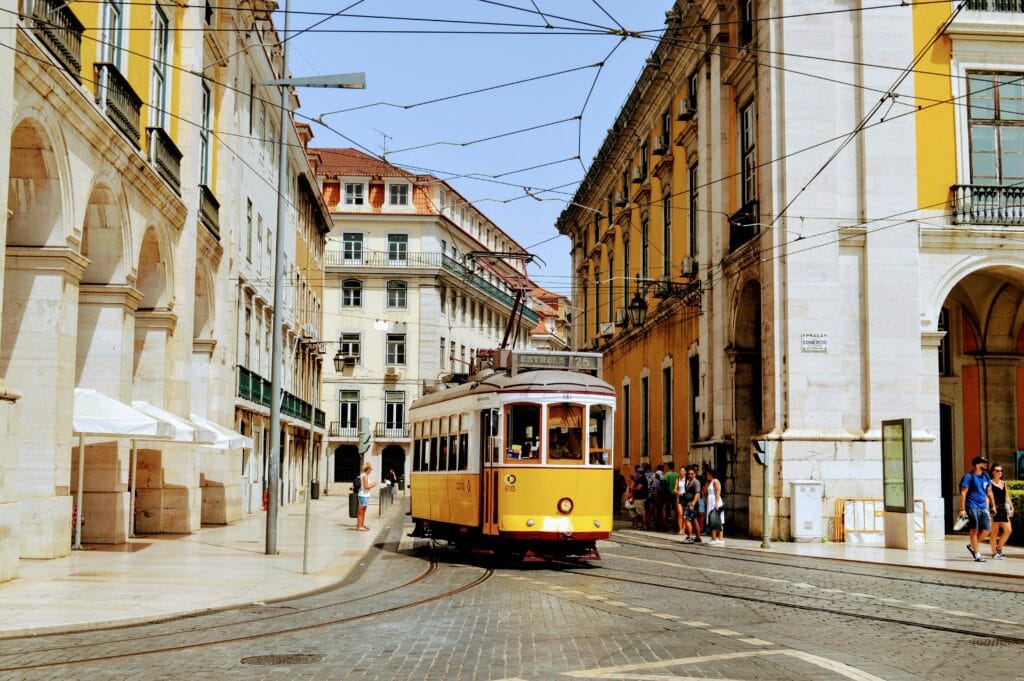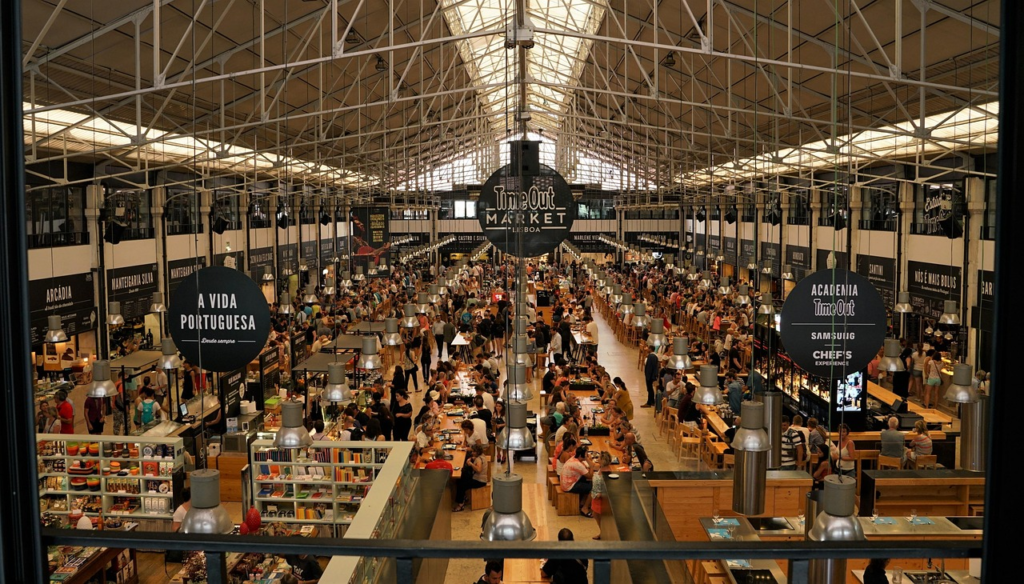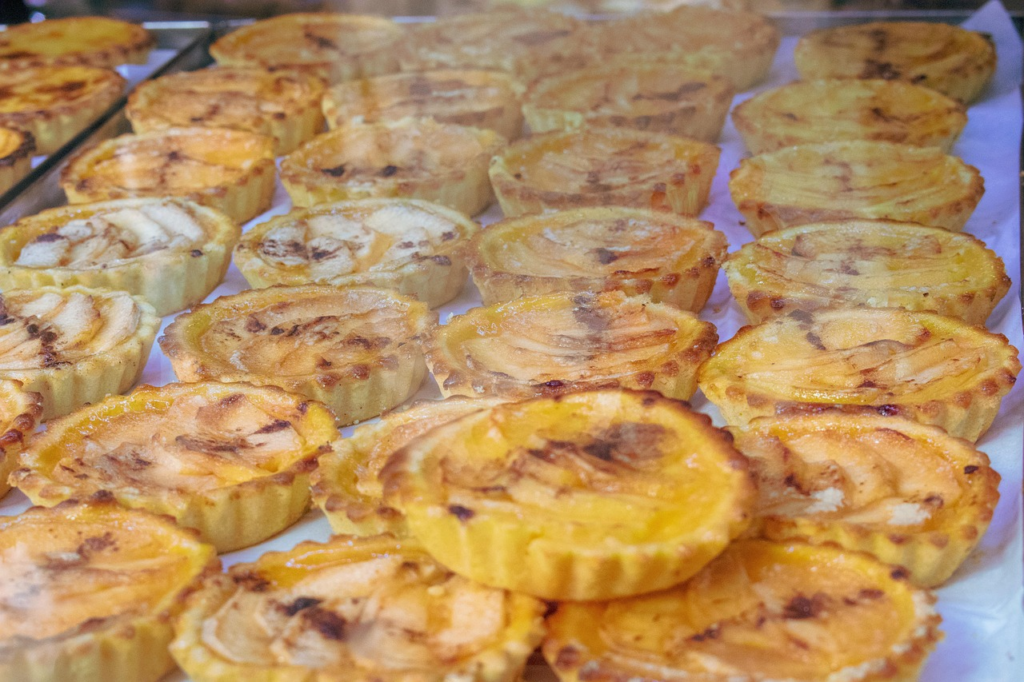Sun-splashed hills, azulejo-clad façades and the salty Atlantic breeze: Lisbon charms without trying. It’s walkable (if hilly), creative, and stitched together by neighbourhood micro-scenes, from old-soul Alfama to design-forward Belém and riverside Alcântara. Cafés spill onto cobbles, fado drifts from tucked-away tascas, and miradouros (viewpoints) turn everyday sunsets into small events.

Where is Lisbon?
Lisbon sits on Portugal’s Atlantic coast at the mouth of the River Tagus (Tejo).
- Language: Portuguese (English widely understood in tourism)
- Currency: Euro (€)
- Population (metro): ~3.0 million
- Best time to visit: Mar–May and Sep–Oct for warm weather and fewer crowds (hot summers; mild, occasionally rainy winters)

How Long to Spend
Lisbon rewards whatever time you give it, but the city breathes best when you don’t rush. In a single day, you can still get a satisfying flavour: wander Baixa and Chiado, climb to Castelo de São Jorge for that terracotta-roof panorama, slip out to Belém for Jerónimos and the tower, then end with fado in Alfama. Three days is the sweet spot, enough to let old and new Lisbon coexist without whiplash. You can linger in the cloisters, graze your way around Time Out Market, dip into the Tile Museum, and balance it with the Oceanário and a golden-hour stroll on the MAAT rooftop or the LX Factory’s rooftops and bookshops. With five days you add depth and rhythm: a proper Sintra excursion (start early, book Pena, leave space for Regaleira or Monserrate), a breezy Cascais and Guincho day for salt and spray, or a slower cultural loop through Gulbenkian and its gardens. However long you stay, plan one neighbourhood per half-day, embrace the hills (or cheat with trams and funiculars), and build in “nata time”—those small, sweet pauses when Lisbon’s viewpoints, light and music do the heavy lifting.
- 24 hours: Baixa/Chiado → Castelo de São Jorge → Belém highlights → fado in Alfama.
- 3 days: Add the National Tile Museum, Oceanário/Parque das Nações, and LX Factory.
- 5 days: Day trips to Sintra (Pena + Regaleira) and Cascais/Guincho; or cross to Cristo Rei.
Tip: Build in “hill time”—you’ll pause more than you think for photos, views and natas.
Where to Stay
Choose vibe + mobility over star ratings.
- Baixa & Chiado (downtown elegance): Grand 18th-century avenues, handsome squares (Praça do Comércio, Rossio), cafés with pavement seating, and easy metro links. Chiado adds theatres, bookstores, boutiques and sleek pâtisseries. It’s the “all roads lead here” bit of Lisbon, flat by Lisbon standards and ideal for first-time orientation.
Best for: First-timers who want to walk to big sights; travellers who like classic city energy, café breaks and people-watching; short stays where convenience trumps quirk.
Note: Busy by day, calmer at night; genuine residential life is thinner than in the hills. Prices reflect the prime location, and street noise can carry on tram routes.
- Alfama (old Lisbon & fado): Moorish-era street maze, azulejos everywhere, pocket-sized squares, laundry lines in the sun, and the sound of fado after dark. Expect steps, slopes and surprise viewpoints (miradouros).
Best for: Romantics, photographers, slow wanderers, culture-curious travellers who like getting “lost” and don’t mind hills. Great if you want to feel embedded in Lisbon’s older rhythms.
Note: Cars rarely reach the door; luggage + cobbles can be a workout. Evenings can be lively around fado houses; mornings feel village-quiet.
- Bairro Alto & Príncipe Real (nightlife & indie style): Two linked hills with different moods. Bairro Alto is bohemian and bar-dense after dark; by day it’s sleepy with tiled façades and tiny ateliers. Príncipe Real is chic, antique shops, design stores, Saturday organic market, pretty gardens and handsome townhouses.
Best for: Night owls, foodies chasing wine bars and bistros, style-seekers who love browsing concept stores and weekend markets.
Note: Bairro Alto streets can be loud until late (especially weekends). Príncipe Real is calmer and upscale but still a short stroll to the action and viewpoints.
- Belém (riverside culture): Big-ticket history and culture. Jerónimos Monastery, Belém Tower, MAAT, spaced out along a breezy riverfront with cycling lanes and lawns. Daytimes bring sightseers; evenings are quieter and local.
Best for: Culture lovers, runners and cyclists, families who want elbow room and playgrounds, travellers who prioritise museum days over nightlife.
Note: It’s a tram/train hop from the centre, so plan your evenings; restaurants skew daytime. Gorgeous for sunsets and early-morning walks before the tour buses roll in.
- Parque das Nações (modern & step-free): Lisbon’s contemporary face. flat promenades, public art, Oceanário, cable car, wide pavements and plentiful green space. Architecture is newer; streets are calm and practical.
Best for: Families with buggies, business travellers, anyone who values lifts, ramps and step-free access; early flights (airport is close) and runners who want breezy riverside routes.
Note: Less “old-world charm”; evenings are low-key with mall dining and modern cafés rather than tascas and taverns.
- Alcântara (LX Factory creative grit): Industrial bones turned creative hub. street art, pop-up markets, third-wave coffee, rooftop sundowners and a community of makers at LX Factory. Under the 25 de Abril Bridge, the scenery has character and big-bridge drama.
Best for: Design lovers, digital nomads, café hoppers, travellers who like a lived-in creative scene over polished postcard streets.
Note: It’s between the centre and Belém. great for day-tripping both ways. Nights are vibey around venues but residential streets nearby stay fairly relaxed.

Quick matcher:
Central & flat → Baixa/Chiado • History & fado → Alfama • Bars & boutiques → Bairro Alto/Príncipe Real • Museums & river paths → Belém • Step-free & airport access → Parque das Nações • Coffee & creatives → Alcântara
How to Get Around
- From the airport (LIS): Metro runs directly to the centre; buses, taxis and ride-hail are easy.
- Public transport: Metro, trams and buses cover most sights; tap a Viva Viagem card (contactless bank cards also work at gates).
- Iconics: Tram 28E is scenic but crowded. ride early/late, board at a terminus, and watch your pockets.
- Hills help: Funiculars and lifts save your legs (check current status if there are service reviews).
- On wheels: GIRA bike-share is great along the flat riverfront.
- Taxis & apps: Uber/Bolt operate; official taxis are metered—use ranks or apps at the airport.
What to do in Lisbon

Belém Tower (Torre de Belém)
Lisbon’s stone sentinel and symbol of the city; pair it with riverside strolls. Climb the narrow spiral staircases for turret views and notice the ropes, armillary spheres and sea creatures carved into the limestone. Go early morning for soft light and fewer tours, then follow the promenade for a relaxed walk along the Tagus.
Jerónimos Monastery
Spellbinding cloisters and nautical flourishes near the launch point of the Age of Discoveries. The cloister’s lace-like arches frame quiet courtyards. linger to spot maritime motifs and explorers’ symbols. Combine with the nearby church of Santa Maria de Belém and give yourself time; it’s easy to spend an hour just tracing the stonework.

MAAT (Museum of Art, Architecture & Technology)
A wavelike riverside museum whose roof doubles as a public terrace. The exhibitions rotate across contemporary art, design and tech, so check what’s on, there’s often something thought-provoking. Walk over the top for river panoramas, then continue on foot towards Belém or back to Cais do Sodré.
Time Out Market (Mercado da Ribeira)
Lisbon’s buzziest food hall with chef-led kiosks under one roof. It’s ideal for groups because everyone can order from different counters and still sit together. Arrive off-peak (late morning or mid-afternoon) for elbow room, and don’t skip the dessert stands for a pastel de nata chaser.

Castelo de São Jorge
Hilltop fort with sweeping views over terracotta rooftops and the river. Wander the ramparts, meet the resident peacocks, and duck into the small museum to see archaeological finds from Roman to Moorish eras. Sunsets here are special, bring a bottle of water and take it slow on the cobbles.
Alfama wander + fado
Lisbon’s oldest quarter is made for aimless exploring: lanes, laundry lines, and tiled doorways. Book a fado session for evening, intimate venues turn dinner into a moving, candlelit concert. Between songs, pause at miradouros like Santa Luzia for azulejo panels framing the view.
National Tile Museum (Museu Nacional do Azulejo)
A beautiful 16th-century convent turned temple to azulejos. Start with early Hispano-Moorish pieces and progress to grand blue-and-white panels; the evolution tells Lisbon’s story in ceramic. Don’t miss the long 18th-century panorama of the city, it’s like time travel before the 1755 earthquake.
Calouste Gulbenkian Museum
One of Europe’s great private collections, from Egyptian artefacts to Monet and Lalique. The galleries are calm and perfectly lit, making it easy to linger without museum fatigue. When you’re done, the surrounding gardens are a lovely spot for a sandwich or a quiet read.
Oceanário de Lisboa
A soaring, modern aquarium wrapped around a vast central tank. Kids love spotting sunfish, rays and sharks drifting through the same space; adults tend to get hooked by the thoughtful conservation displays. Make it a half-day with a riverside stroll and cable-car ride nearby.
LX Factory (Alcântara)
Industrial-chic complex of indie shops, cafés and street art under the red span of the 25 de Abril Bridge. Pop into the famous bookshop for a photo, then browse weekend markets for local makers. It’s also a great sundowner spot, rooftop bars here catch the evening glow over the river.
Tram 28E (ride smartly)
The classic yellow tram rattling through Alfama, Baixa, Estrela and Graça. Aim for first thing in the morning or after dinner to sidestep queues, and board at a terminus for seats. Keep bags zipped and enjoy the creaks and climbs, it’s a moving postcard of old Lisbon.
Pastel de nata pilgrimage
Benchmark the city’s iconic custard tart at two legendary stops. In Belém, grab a warm box to go and eat them on a bench by the river; in the centre, Manteigaria’s open kitchen lets you watch the pastry ballet. Sprinkle cinnamon, add a short espresso, and you’re basically a local.
Parque das Nações waterfront
Contemporary Lisbon with boardwalks, public art, and wide-open river views. It’s flat and stroller/bike-friendly, great for families who want a break from hills. Pair the Oceanário with the cable-car for aerial views, then refuel at one of the modern cafés along the promenade.
Day trip: Sintra
Fairy-tale palaces set in misty hills and lush gardens. Book timed entry for Pena, arrive early, and use local buses or tuk-tuks to save your legs between sights. Mix grand hits (Pena, Regaleira) with a quieter stop like Monserrate for a calmer, romantic finale.
Day trip: Cascais & Guincho
Sunny resort town vibes with an artsy museum quarter and easy beach access. Stroll the marina, dip your toes at calmer town beaches, then bus or bike to windswept Guincho for Atlantic drama. On the return, stop at Boca do Inferno for sea-spray theatrics and a photo stop.
Food & Drink in Lisbon
Food
- Pastel de nata Monastic egg-yolk alchemy linked to Jerónimos; Pastéis de Belém baking since 1837. Compare with Manteigaria.
- Bacalhau (salt cod) “365 recipes” folklore; try à Brás or Gomes de Sá.
- Sardinhas assadas Street grills blaze during Santo António (June); great through summer with vinho verde.
- Bifana & prego Garlicky pork or minute-steak in a roll, perfect with a cold beer.
- Amêijoas à Bulhão Pato Garlic-herb clams (order extra bread for the sauce).
- Caldo verde Silky potato + shredded greens; homely and ubiquitous.
- Conservas Beautiful tinned fish (e.g., Conserveira de Lisboa, est. 1930) for gifts or picnics.
- Petiscos Portugal’s small-plates culture: octopus salad, cod fritters, pica-pau, cheeses, cured meats.

Drinks
- Ginjinha: Quick cherry-liqueur shot “com elas” (with a cherry) at tiny counters like A Ginjinha, a proper Lisbon ritual.
- Wine: Whites, vinho verde (lightly spritzy) for seafood; reds, Douro and Alentejo are reliable.
- Beer & craft: Beyond Sagres/Super Bock, check taprooms like Dois Corvos and Musa.
- Coffee: Ask for um café (espresso) or bica; abatanado (long), pingado/garoto (dash of milk), meia de leite (half-and-half). Stand at the counter for the cheapest price and the most local vibe.
Markets & easy grazing:
- Time Out Market for a curated greatest-hits lunch.
- Mercado de Campo de Ourique for a local-leaning evening graze without the big-tourist crush.
- Street-level pastelarias for breakfast and tascas for honest daily specials (prato do dia).
Etiquette & money-savvy:
- Couvert (bread/olives/cheese) isn’t free unless you eat it, say “Não, obrigado/a” if you don’t want it.
- Tipping isn’t mandatory—round up or 5–10% for great service is appreciated.
- Timing: Lunch ~12:00–15:00; dinner from ~19:30. Book small, popular spots or arrive early.
Wherever you base yourself, hilltop lanes or riverside paths, Lisbon rewards slow mornings, golden-hour wanders and the odd detour for a still-warm pastel de nata. Come curious, pack comfy shoes, and let the city’s light, music and easy warmth do the rest.






